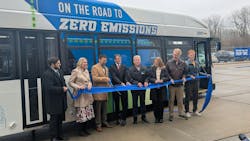Hawaiʻi County, CATA expand transit fleets with new vehicle purchases
Public transit agencies across the country have been upgrading and expanding their vehicle fleets, both taking steps towards introducing more zero-emission saturation and service expansion.
Hawaiʻi County expands paratransit fleet, adds battery-electric buses
The county of Hawaiʻi held a blessing ceremony for the introduction of nine new paratransit vans and four all-electric buses to expand its vehicle fleet.
The paratransit vehicles it purchased include two six-passenger vans and seven eight-passenger vans, each hosting wheelchair accessibility equipment. With the addition of the new vehicles, the county’s mass transit agency now has a fleet of 16 vehicles for its paratransit service—a move aimed at increasing on-time performance and reliability for passengers.
“It is quite remarkable that we can more than double the size of our paratransit fleet,” said Hawaiʻi Mayor Kimo Alameda. “Everyone needs access to transportation, and we are excited to be able to improve services for our disabled residents on these routes.”
The paratransit service provides up to one mile of fixed routes in Hilo, Kona and Puna.
“We are very pleased to add these new vehicles to our fleet,” said Mass Transit Agency Administrator Zachary Bergum. “These new all-electric buses mark an important step toward reducing our emissions, and as paratransit ridership continues to increase, these vans will ensure that we meet demand for this critical service.”
A schedule for the paratransit services can be found on the county’s website.
CATA unveils its first full-size electric bus
The Capital Area Transportation Authority (CATA) revealed its first full-size electric bus at a ribbon cutting ceremony, a milestone in the agency’s efforts to reach net-zero carbon emissions by 2035. The new GILLIG manufactured bus will enter service later this year.
“This bus isn’t just a new vehicle, it’s a symbol of our commitment to cleaner air, quieter streets and modern mobility for our community,” said CATA CEO Bradley Funkhouser. “By deploying this electric bus, we’re taking a decisive step toward our zero-emission target for 2035, and we’re doing so in partnership with local, state and federal leaders who share our vision.”
The new bus is also part of CATA’s effort to replace aging diesel buses in its fleet that are nearing the end of their useful life while moving toward cleaner, more energy-efficient vehicles. The purchase was funded via a combination of both state and federal resources, including a little over $1 million from the Federal Transit Administration’s (FTA) Low- or No-Emission Grant Program and $257,940 in state matching funds from the Michigan Department of Transportation’s (MDOT) Comprehensive Transportation Fund (CTF).
“When the CATA board adopted the zero-emission fleet transition plan, we recognized the enormous value to our community: lower emissions and operating costs, modernized service and alignment with regional and state climate goals,” said CATA Board Chair Nathan Triplett. “Today’s unveiling is the culmination of years of planning and the beginning of an exciting new chapter for public transportation in Mid-Michigan. We are moving from commitment to action.”
“MDOT is proud to partner with CATA to bring next-generation, zero-emission transit to Lansing. Our investment of more than a quarter-million dollars — paired with federal grant dollars — demonstrates Michigan’s commitment to sustainable mobility,” said MDOT Office of Passenger Transportation Administrator Jean Runestman. “Together, we are reducing transportation emissions, improving reliability and strengthening the transit network that so many Michiganders rely on.”
CATA says its new electric bus will have a positive environmental impact through replacing one of the agency’s diesel buses, which only averages 4-4.5 miles per gallon. The agency has mapped its potential savings, noting that electric buses can achieve the equivalent of 29-30 miles per gallon at a lower cost: about $0.19 per mile compared to $0.75 per mile it experiences with the current diesel fleet.
CATA’s electric bus deployment will be supported by expanded charging infrastructure at its operations facility, driver and maintenance staff training and phased replacement of diesel and hybrid vehicles over the coming decade. CATA says it’s now poised to take a leap forward by bringing the latest generation of EVs to its passenger fleet.
CATA is also coordinating with the Lansing Board of Water & Light to ensure that its operations and maintenance facility it properly equipped with the electrical capacity to support current and future charging infrastructure needs.
About the Author
Noah Kolenda
Associate Editor
Noah Kolenda is a recent graduate from the Craig Newmark Graduate School of Journalism with a master’s degree in health and science reporting. Kolenda also specialized in data journalism, harnessing the power of Open Data projects to cover green transportation in major U.S. cities. Currently, he is an associate editor for Mass Transit magazine, where he aims to fuse his skills in data reporting with his experience covering national policymaking and political money to deliver engaging, future-focused transit content.
Prior to his position with Mass Transit, Kolenda interned with multiple Washington, D.C.-based publications, where he delivered data-driven reporting on once-in-a-generation political moments, runaway corporate lobbying spending and unnoticed election records.

